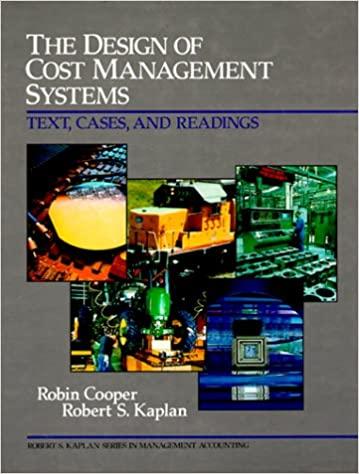Question
We can take the example of Cement Manufacturing Company. -Types of Products of Cement Industry: Cement is one of the necessary materials in construction. Cement
We can take the example of Cement Manufacturing Company. -Types of Products of Cement Industry: Cement is one of the necessary materials in construction. Cement is classified into various categories based on its composition, and specific end uses. Cement is classified as either portland, blended, or specialty cement. 1. Portland cement Portland cement is the most common type of cement. It's an essential ingredient of concrete. Portland cement is a mixture of limestone and clay. It's ground and burnt at a very high temperature to form clinker. The clinker is ground into a fine powder. There are different types of portland cement. Each kind of portland cement has a different chemical composition. However, the manufacturing process is the same for each kind of portland cement. 2. Blended cement In manufacturing blended cement, certain natural or human-made compounds such as sandstone are mixed with portland cement and ground together. Blended cement is more suitable for specific applications compared to portland cement. It is used for significant concrete works such as dams. 3. Specialty cement Specialty cement has several unique properties. They are used in specific applications like urgent repairs and super high strength applications. -Now, we will get to know about the three manufacturing cost categories: Manufacturing cost is the sum of costs of all resources consumed in the process of making a product. The manufacturing cost is classified into three categories: direct materials cost, direct labor cost, and manufacturing overhead. 1. Direct materials cost: Direct materials are the raw materials that become a part of the finished product. The manufacturing process adds value to the raw materials by doing various operations to maintain a deliverable product. There are many operations that can be applied to natural materials such as welding, mixing, pouring, cutting and painting, threading. 2. Direct labor cost: The direct labor cost is the cost of workers (Skilled, Semi-Skilled, Unskilled) who can be easily identified with the unit of production. 3. Manufacturing overhead: Manufacturing overhead is any manufacturing cost that is neither direct materials cost nor direct labor cost. Manufacturing overhead includes all charges that provide support to the manufacturing of the finished product from the raw material. -Specific manufacturing costs that cement companies incur to produce cement are as follows: 1. Power and Fuel Cost (Manufacturing Overhead): The cement industry relies on power and its fuel. Power and fuel costs account for approx 25-30% of the price of cement when it's sold. As a result, power and fuel have a major impact on the company's operating expenditure. Different varieties of fueldiesel, coal, and ligniteare used in the process. Cement plants require different amounts of power based on the heat treatment process that's being used. This cost will be categorized as a Mixed Cost i.e., Semi variable since this cost depends on the production of cement. Also, some of the power and fuel cost will be fixed irrespective of the output. 2. Limestone and Raw material Cost (Direct Material): The second major component in the production of cement is the cost of raw materials. The most primary raw material that's used is limestone. Raw materials account for around 40% of the cost of sales. Cement plants are generally located near limestone reserves because limestone can't be transported to long distances. Apart from limestone, other raw materials used in the cement industry are fly ash gypsum, etc. This cost will be categorized as Variable Cost since this cost depends on the volume production of cement. 3. Transportation cost (Manufacturing Overhead): In the cement sector, the manufacturing facilities and end-user markets are considerable distances from each other. Cement plants are located near limestone reserves. As a result, cement has to travel a considerable distance to reach the end-users. Since the cement is a low-value, high-volume commodity, transporting it to the end-user accounts for a significant portion of the cost for cement manufacturersit constitutes almost 10% of the cost of sales. This cost will be categorized as Variable Cost since this cost depends on the volume production of cement, and these expenses will rise and fall with the efforts you make to increase sales. 4. Salaries and Wages (Direct Labour): Piece rate wages earned, Incentive wages earned, Overtime wages earned, (d) Earnings of casual labor, etc. are the expenses of the company towards labor. This cost will be categorized as Variable Cost since this cost depends on the volume production of cement. Reference Lothenbach, Barbara; Scrivener, Karen; Hooton, R.D. (December 2011). "Supplementary cementitious materials". Cement and Concrete Research. 41 (12): 12441256. Courland, Robert (2011). Concrete planet: the strange and fascinating story of the world's most common man-made material. Amherst, N.Y.: Prometheus Books. ISBN 978-1616144814. Retrieved 28 August 2015.
This week we focused on manufacturing costs, but selling, general, and administrative (SG&A) costs are also important. Using the company you selected for the discussion forum question, what specific types of SG&A costs would the company incur? How would these costs be considered in product costing?
As portfolio activities are to be self-reflective, please make sure to connect the portfolio assignment to:
- Your personal experiences. Reflect on how this assignment topic is applicable to and will benefit you.
- Course readings and any external readings.
- Discussion forum posts or course objectives.
The Portfolio Activity entry should be a minimum of 500 words and not more than 750 words. Use APA citations and references if you use ideas from the readings or other sources.
Step by Step Solution
There are 3 Steps involved in it
Step: 1

Get Instant Access to Expert-Tailored Solutions
See step-by-step solutions with expert insights and AI powered tools for academic success
Step: 2

Step: 3

Ace Your Homework with AI
Get the answers you need in no time with our AI-driven, step-by-step assistance
Get Started


